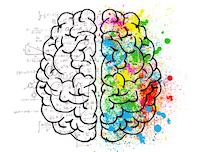- Psychological Safety: An overview. For the science, see the SAFETY model. For Google's research into why it's important for high performing teams, see Project Aristotle. What happens when we don't have that safety?
- Anxiety and Stress: For the science, see Polyvagal Theory or a description of some neuroscience, illustrated with a bear encounter. To let go of that anxiety, see the Anti-Anxiety toolkit.
- Recommended reading: I'm often asked for book recommendations.
- Generally more about the brain: Cognitive bias, motivation, default mode network, systems 1 & 2 and neurotransmitters (chemicals) that drive behaviour.
- Language patterns: Why language is so important, and Clean Language, a specific language pattern that has excellent application for coaching.
- Improving your meetings: Specifically retrospectives (my video course), and standups. What if your people won't participate?
- Improving learning: with neuroscience and LEGO.
- Something fun: The millennial whoop, and inattentional blindness.
Growth vs Fixed mindsets and the influence of AI
In her book Mindset: The New Psychology of Success, Carol Dweck talks about the difference between the Growth and Fixed mindsets. I’d encourage you to read her words on this, but in a nutshell, people with a growth mindset believe that their intelligence can expand and develop, whereas people with a fixed mindset believe that intelligence is fixed and what you’ve got now is all you’re getting.
Tacit knowledge
When I was a teenager, I read a book called Juggling for the Complete Klutz, which seemed just perfect for me. It came with three bean bag balls, and instructions on how to use them.
Motivation and deadlines
While in a meeting, I heard “It’s easier to get things done when there is a deadline”, and that tells me something about motivation, or more specifically, lack of it.
Sometimes we just need to pick up the fax machine
My friend Dave once got brought in to help with a large project. The company was purchasing a large fax system from a vendor and then planned to extensively customize it to work in their environment.
LEGO Serious Play and Threat Modeling
Here’s a great case study of how the World Wide Web Consortium (W3C) has used LEGO® Serious Play® to do threat modeling around digital identity.
What can we share from a retrospective?
We talk a lot about having a safe space for a retrospective, about creating that environment where it’s safe to open up and honestly talk about the real problems. We tell management that they should have no expectation of knowing about the specific conversations that went on inside a team’s retro, and that’s correct.
Larger retrospectives
In my Retrospective Magic course, I’m mostly focused on team based retrospectives, and I was asked this week what needs to change when we’re doing a larger one?
Appeal to authority and GenAI
“Appeal to authority” is both a commonly used persuasion technique, and also a logical fallacy described in the excellent book Logically Fallacious: The Ultimate Collection of Over 300 Logical Fallacies. It’s when we insist that a claim is true simply because a recognized authority said it was true, and without any actual supporting evidence.
Secondary Gain and Work in Progress (WIP)
I think by now we all understand that having too many things in progress at once is a negative on almost all counts. We get less accomplished, our quality drops, and we generally feel more overwhelmed. Yet, we continue to start more work than we can finish, over and over again. Why might this be?
A decade with LEGO Serious Play
I just realized that it’s been ten years since I first took LEGO® Serious Play® training with Robert Rasmussen. I have this listed on my business cards and it’s amazing how many great conversations this starts. LEGO seems so out of place in a business context, that people immediately want to know more.
